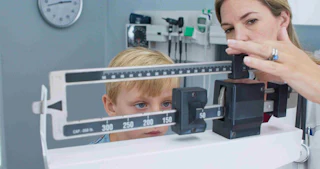How to Measure a Child’s Height and Weight Accurately: A Guide for Healthcare Providers

Accurate height and weight measurements are essential in pediatric care. These simple numbers provide the foundation for growth charts, Body Mass Index (BMI) calculations, and early detection of potential health concerns. For healthcare providers, correct measurement techniques are critical to ensuring accurate assessments, guiding interventions, and supporting families with reliable information.
This provider-focused guide expands on the Greaux Healthy how to measure a child's height and weight handout to walk you through best practices for measuring height and weight in children, interpreting results, and integrating data into everyday clinical care.
Why Accurate Pediatric Measurements Matter
- Growth Monitoring: Detect growth disorders, malnutrition, or obesity early.
- BMI & Percentiles: BMI-for-age percentiles are essential in evaluating children ages 2-19.
- Clinical Decisions: Measurements guide treatment plans, referrals, and family counseling.
- Public Health Impact: Reliable data supports obesity prevention, population health surveillance, and program evaluation.
Inaccurate measurements can lead to misdiagnosis, unnecessary interventions, or missed opportunities for prevention.

Preparing for Height and Weight Measurement
Equipment You’ll Need
- Height: Stadiometer (preferred), or wall with flat surface, ruler, and paper for marking.
- Weight: Calibrated digital scale on a firm, flat, non-carpeted surface.
- Back-up tools: Tape measure, step stool, or sturdy flat edge for clinics without stadiometers.
Patient Preparation
- Ask the child to remove shoes, bulky clothing, hats, and hair accessories.
- Empty pockets for accurate weight.
- Explain to the child about how weight is just another data point, like heart rate, to take the pressure off the sensitive topic
- Ensure the child is comfortable and understands the process.
How to Measure Height in Children
- Position the child against a wall or stadiometer: heels, buttocks, shoulders, and head touching.
- Align their eyes so the line of sight is horizontal (“Frankfurt Plane”).
- Use a flat headpiece or ruler at a right angle to the wall, gently resting on the crown of the head.
- Record measurement to the nearest 0.1 cm (1/8 inch).
- Repeat twice; if results measurements differ by more than 0.3 cm, take a third measurement.
Tip: Keep your eye level with the headpiece to avoid parallax error.

How to Measure Weight in Children
- Place the scale on a hard, flat surface.
- Confirm the scale reads zero before use.
- Ask the child to stand still, centered, with feet flat and arms at their sides.
- Record weight to the nearest 0.1 kg (0.2 lb).
- Repeat twice; if measurements differ by more than 0.1 kg, take a third measurement.

Calculating and Interpreting BMI in Children
- Use both BMI and BMI percentile (adjusted for age and sex).
- Percentiles categorize weight status:
- < 5th percentile: Underweight
- 5th–84th: Healthy weight
- 85th–94th: Overweight
- ≥ 95th: Obese
👉 Try the BMI Percentile Calculator from Pennington Biomedical for accurate results. We also offer a condensed version of the 2023 AAP clinical practice guidelines refined by leading experts and made for Louisiana in our Childhood Obesity Prevention, Evaluation and Treatment Toolkit
Note for providers: BMI does not distinguish fat from lean mass. Consider additional assessments (e.g., waist-to-height ratio) for more complete evaluations.
Best Practices for Healthcare Providers
- Train staff on consistent measurement protocols and person-first language.
- Calibrate equipment annually and check zero before each use.
- Use replicates to ensure accuracy.
- Document and track measurements over time to identify growth patterns.
- Communicate results sensitively to families focusing on health behaviors

For pediatric healthcare providers, accurate height and weight measurements are more than routine. They are the foundation for effective care. Following standardized methods ensures reliable data, helps identify children at risk, and supports families in building healthier futures.
For more clinical tools, resources, and training, visit